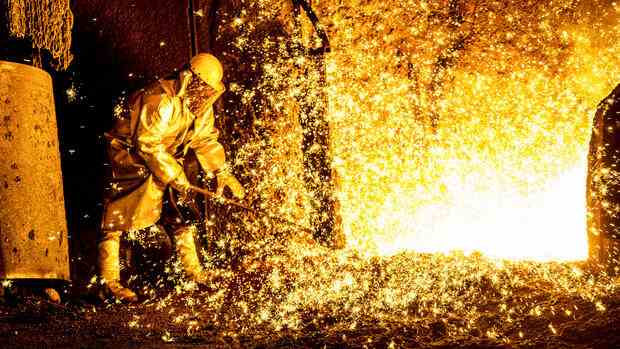Berlin The climate-neutral conversion of the energy-intensive sectors of steel, basic chemicals and cement should be promoted with more targeted government support. This is the result of the study “Economic Evaluation of Climate Policy Instruments” by the Bertelsmann Foundation, which is available to the Handelsblatt. It is also necessary “that Germany shifts up a gear in the transformation – to achieve the climate goals, but also to maintain domestic competitiveness”.
The study is the result of almost a year of work. It highlights the tools that the steel, basic chemicals and cement sectors can use to reduce their CO2 emissions to zero (decarbonization), taking into account input from the Federal Ministry of Economics and the sectors concerned.
Marcus Wortmann from the Bertelsmann Foundation makes it clear that there is no model for supporting the transformation that would be suitable for the entire basic industry: “Sector-specific solutions are required. Instruments such as climate protection agreements, a CO2 border adjustment and free certificates in emissions trading must be combined in a way that is adapted to the conditions in the industry,” says Wortmann.
Of the three sectors, there is a particularly great need for action in the steel industry. The steel companies have to convert their production to hydrogen-based processes. That requires massive investments.
Added value of 220 billion euros
At the same time, the conditions of European emissions trading have recently been significantly tightened. Emissions trading obliges industry to buy a certificate for every tonne of CO2 emitted. Companies that are in international competition are allocated some of the certificates free of charge. However, the free allocation is reduced from year to year. In return, a CO2 border adjustment will be introduced to protect European companies from steel imports from regions that have lower CO2 costs.
Wortmann’s summary of the industry: “The problems are greatest in steel production. At the same time, time is pressing. Companies need reliable regulations in the short term.” The industry is already heavily burdened compared to its non-European competitors.
According to the study, a combination of subsidies, for example in the form of climate protection agreements, and CO2 border adjustments can be used to buy significant CO2 savings in the steel industry, while at the same time the change in technology is brought forward. Compared to simply reducing the allocation of free emission certificates, the cumulative value added amounts to 220 billion euros.
Among the instruments intended to enable industry to transform, the Federal Ministry of Economics and Technology attaches great importance to climate protection agreements. The climate protection agreements are intended to compensate for the additional costs that companies incur as a result of more climate-friendly production. According to the Federal Ministry of Economics, the first climate protection agreements are to be signed this year.
Economics Ministry relies on climate protection agreements
In December last year, the ministry published the draft of a funding guideline and consulted associations, federal states and experts. The funding guideline was revised on this basis. According to the ministry, it should “soon be finalized with the other departments”. The aim is for the funding guideline to come into force in the first half of 2023 and then “tenders for climate protection contracts will take place promptly”. The state aid approval procedure at the EU Commission has already been initiated.
In the federal budget for 2023, more than 2.2 billion euros are available for climate protection agreements together with the funding program for decarbonization of industry. In addition, funds of currently up to 68 billion euros for the years up to 2040 are provided for the financing of both projects in the form of so-called “commitment authorizations”.
Basic chemicals also have to invest billions to manage the path to climate neutrality. The technology change requires the exchange of a third of the existing capital stock and ensures higher power consumption.
According to the study, with an optimal combination of a CO2 border adjustment with investment cost subsidies and compensation for the higher operating costs, the tax authorities would incur costs of ten billion euros by 2042. At the same time, the CO2 border adjustment would generate income of 1.4 billion euros.
By using this bundle of instruments, the emission of 126 million tons of CO2 could be prevented compared to the pure reduction of the free allocation of CO2 certificates. At the same time, 99 billion euros in added value in basic chemistry could be secured, according to the study.
“Subsidies are worthwhile for strategic reasons”
The situation is different for the cement industry. It is not subject to the same global competitive pressures as the other two sectors. Their domestic production is mainly used as an input for the construction industry, and trade intensity is low. The authors write that systems for separating and storing CO2 (carbon capture and storage, or CCS for short) are of central importance for the climate neutrality of the cement industry.
State subsidies would make emission-free cement production possible from the end of 2031 and thus accelerate it by five years. “The earlier technology change would cost the state about three billion euros,” write the authors. According to the study, the subsidy could secure 3.1 billion euros in added value that would be lost if the number of free certificates in Germany were simply reduced.
Wortmann is convinced that the billions would be a good investment for the three sectors: “For strategic reasons, it is worth maintaining the raw materials industry in Germany and Europe. Preserving the primary industry strengthens resilience, secures value chains and can become a successful model for climate protection.”
More: How Habeck wants to revive the photovoltaic industry
